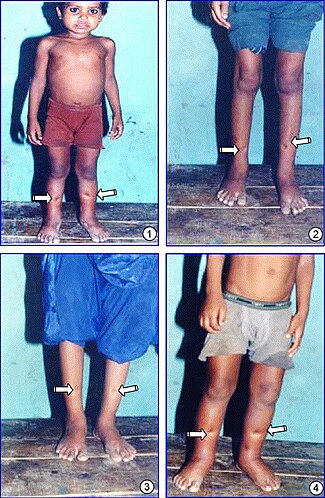| Epidemic Dropsy | |
|---|---|
 | |
| Epidemic dropsy patients with the characteristic bilateral pitting edema of the extremities (indicated by arrows) | |
| Specialty | Emergency medicine |
Epidemic dropsy is a form of edema of extremities due to poisoning by Argemone mexicana (Mexican prickly poppy).[1][2]
Epidemic dropsy is a clinical state resulting from use of edible oils adulterated with Argemone mexicana seed oil.
Sanguinarine and dihydrosanguinarine are two major toxic alkaloids of argemone oil, which cause widespread capillary dilatation, proliferation and increased capillary permeability. When mustard oil is adulterated deliberately (as in most cases) or accidentally with argemone oil, proteinuria (specifically loss of albumin) occurs, with a resultant edema as would occur in nephrotic syndrome.
Other major symptoms are bilateral pitting edema of extremities, headache, nausea, loose bowels, erythema, glaucoma and breathlessness.
Leakage of the protein-rich plasma component into the extracellular compartment leads to the formation of edema. The haemodynamic consequences of this vascular dilatation and permeability lead to a state of relative hypovolemia with a constant stimulus for fluid and salt conservation by the kidneys. Illness begins with gastroenteric symptoms followed by cutaneous erythema and pigmentation. Respiratory symptoms such as cough, shortness of breath and orthopnoea, progressing to frank right-sided congestive cardiac failure, are seen.
Mild to moderate anaemia, hypoproteinaemia, mild to moderate renal azotemia, retinal haemorrhages, and glaucoma are common manifestations. There is no specific therapy. Removal of the adulterated oil and symptomatic treatment of congestive cardiac failure and respiratory symptoms, along with administration of antioxidants and multivitamins, remain the mainstay of treatment.[1]
Epidemic dropsy occurs as an epidemic in places where use of mustard oil from the seeds of Brassica juncea, commonly known as Indian mustard, as a cooking medium is common.[2] This is because there is an increased chance of adulteration (with argemone oil) and consumption of such adulterated mustard oil in these areas.
- ^ a b Sharma, B. D.; Malhotra, S.; Bhatia, V.; Rathee, M. (November 1999). "Epidemic dropsy in India". Postgraduate Medical Journal. 75 (889): 657–661. doi:10.1136/pgmj.75.889.657. PMC 1741391. PMID 10621875.
- ^ a b Das, M.; Khanna, S. K. (1997). "Clinicoepidemiological, Toxicological, and Safety Evaluation Studies on Argemone Oil". Critical Reviews in Toxicology. 27 (3): 273–297. doi:10.3109/10408449709089896. PMID 9189656.